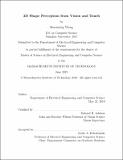| dc.contributor.advisor | Edward H. Adelson. | en_US |
| dc.contributor.author | Wang, Shaoxiong(Scientist in electrical engineering and computer science)Massachusetts Institute of Technology. | en_US |
| dc.contributor.other | Massachusetts Institute of Technology. Department of Electrical Engineering and Computer Science. | en_US |
| dc.date.accessioned | 2019-11-12T18:13:15Z | |
| dc.date.available | 2019-11-12T18:13:15Z | |
| dc.date.copyright | 2019 | en_US |
| dc.date.issued | 2019 | en_US |
| dc.identifier.uri | https://hdl.handle.net/1721.1/122914 | |
| dc.description | This electronic version was submitted by the student author. The certified thesis is available in the Institute Archives and Special Collections. | en_US |
| dc.description | Thesis: S.M., Massachusetts Institute of Technology, Department of Electrical Engineering and Computer Science, 2019 | en_US |
| dc.description | Cataloged from student-submitted PDF version of thesis. | en_US |
| dc.description | Includes bibliographical references (pages 47-52). | en_US |
| dc.description.abstract | Perceiving accurate 3D object shape is important for robots to interact with the physical world. Current research along this direction has been primarily relying on visual observations. Vision, however useful, has inherent limitations due to occlusions and the 2D-3D ambiguities, especially for perception with a monocular camera. In contrast, touch gets precise local shape information, though its efficiency for reconstructing the entire shape could be low. In this thesis, we propose a novel paradigm that efficiently perceives accurate 3D object shape by incorporating visual and tactile observations, as well as prior knowledge of common object shapes learned from large-scale shape repositories. We use vision first, applying neural networks with learned shape priors to predict an object's 3D shape from a single-view color image. We then use tactile sensing to refine the shape; the robot actively touches the object regions where the visual prediction has high uncertainty. Our method efficiently builds the 3D shape of common objects from a color image and a small number of tactile explorations (around 10). Our setup is easy to apply and has potentials to help robots better perform grasping or manipulation tasks on real-world objects. | en_US |
| dc.description.statementofresponsibility | by Shaoxiong Wang. | en_US |
| dc.format.extent | 52 pages | en_US |
| dc.language.iso | eng | en_US |
| dc.publisher | Massachusetts Institute of Technology | en_US |
| dc.rights | MIT theses are protected by copyright. They may be viewed, downloaded, or printed from this source but further reproduction or distribution in any format is prohibited without written permission. | en_US |
| dc.rights.uri | http://dspace.mit.edu/handle/1721.1/7582 | en_US |
| dc.subject | Electrical Engineering and Computer Science. | en_US |
| dc.title | 3D shape perception from vision and touch | en_US |
| dc.title.alternative | 3-dimensional shape perception from vision and touch | en_US |
| dc.type | Thesis | en_US |
| dc.description.degree | S.M. | en_US |
| dc.contributor.department | Massachusetts Institute of Technology. Department of Electrical Engineering and Computer Science | en_US |
| dc.identifier.oclc | 1126663281 | en_US |
| dc.description.collection | S.M. Massachusetts Institute of Technology, Department of Electrical Engineering and Computer Science | en_US |
| dspace.imported | 2019-11-12T18:13:14Z | en_US |
| mit.thesis.degree | Master | en_US |
| mit.thesis.department | EECS | en_US |
